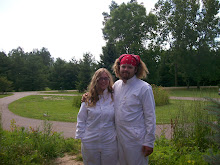
All Hail Honey bees (And Their Pollinating Pals)
by Deborah Franklin
In celebration of National Pollinator Week, NPR's Melissa Block checked in this afternoon with Tucson entomologist Steve Buchmann about the status of America's imperiled honeybees, and what backyard gardeners can do to help save them.
by Deborah Franklin
In celebration of National Pollinator Week, NPR's Melissa Block checked in this afternoon with Tucson entomologist Steve Buchmann about the status of America's imperiled honeybees, and what backyard gardeners can do to help save them.
The precise cause of "colony collapse" among honeybees is still a mystery, Buchmann says. But he cites a glimmer of good news for farmers and produce lovers:
Mother Nature has lots of other pollinators -- typically five to ten types -- that visit a single plant.
Mother Nature has lots of other pollinators -- typically five to ten types -- that visit a single plant.
Still, bumblebees and bats could use tending, too, he says. To improve their lives, try to plant local wildflowers and heirloom fruits and veggies. Native plants suited to the local climate and soil are likelier to flourish and feed bees. Steer clear of the ornately ruffled sophisticates that have spent generations in a hothouse.
Breeding a plant for our taste often inadvertently breeds out the goodies--the sweet nectar--that pollinators seek.
The Pollinator Partnership has an interactive online map to help you figure out what plants will please bees in your zip code. And you can hear more of Block's interview with the former beekeeper tonight on All Things Considered.
How are the honey makers doing in your neighborhood?
Have you noticed a bee decline?





No comments:
Post a Comment